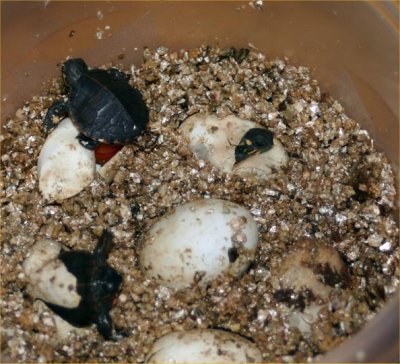 |
 |
|
|
Last Updated: 9/10/08

Sexing Turtles
Turtle Courtship
Legalities
Egg Laying and Care
Hatching Turtle Eggs
Protecting Outdoor Turtle Nests
Baby Turtles
Photos of a Painted Turtle Laying Eggs and the Hatchlings
"How can I tell if it's a girl or boy?"
In general, males have longer front claws, longer tails, and a concave plastron (the bottom shell has a bowl shape to it). Females usually have shorter front claws, shorter tails, and a flat plastron (bottom shell). For box turtles, males often have red eyes and females often have brown or yellow eyes but not always. Male box turtles are usually larger than females. For aquatic turtles, females are often the larger sex.
On 9/19/04, Jeff asked me, "A big turtle was swimming along and a smaller turtle kept swimming in front of the larger, but backwards, and periodically would grab the larger's face and appear to 'tickle' it with its hands/claws, and appeared to kiss or at least touch faces. What kind of behavior is this? Were they playing, courting, kissing, feeding? Was extremely cute to witness." I told Jeff that he was seeing a male court a female. This is how aquatic male turtles impress the females. They have the longer claws which they use to "tickle" the females.
There is specific information on breeding times and numbers of eggs laid and sometimes hatch times in the specific sections under certain species.
See the baby turtle introduction and legalities section.
The collection and release of turtles from/to the wild section may also be of interest.
Female turtles will start to lay eggs when they are mature. They will lay eggs with or without a male present. If there is no male present, the eggs will not be fertile and can be discarded. After mating, a female may be able to lay fertile eggs for a few weeks or perhaps longer. As eggs develop inside a female, her appetite will wane. She may fast for the few weeks before eggs are laid. Presumably, this is partly to allow for room for the eggs to grow and perhaps because she does not feel so well at that time.
Once ready to lay eggs, the female will start digging. She will prefer loose soil (sterile is better) or slightly damp (so it is easy to dig but not dusty) sand in which to dig. It is good to provide a container of those things. If she does not have this, she will dig up reptile carpet, bark, or whatever is around, trying to dig a hole. In a bare tank, she will just dig the bare plastic or glass, getting nowhere. Once the hole is to her satisfaction, she will turn and lay the eggs into the hole. If she does not have a hole or cannot make one, she will just dump them on the bare floor or whatever is around. She may even dump them into water. Fertile eggs dumped into the water will die in short order as they drown. If you find turtle eggs in the water, unless they were just laid, they probably will not hatch but you can always try. Infertile eggs are more likely to be dumped in water or bare areas than fertile ones. They are also more likely to be misshapen or otherwise abnormal. The first batch of eggs that a female turtle lays in her life are often misshapen or abnormal as well. Be sure the female has enough calcium in her diet for egg laying by dusting insects, etc. into reptile vitamins and providing foods high in calcium such as kale and turtle commercial foods that say they have calcium in them. A cuttlebone can also be provided for her to gnaw on for calcium.
In rare cases, a female turtle will not be able to lay her eggs. She may have too many. Her calcium may have been too low so that the eggs broke inside her. Or, she may develop an infection. An x-ray at the vet can tell you if she is carrying eggs. If egg bound, a vet may be able to remove the eggs. I am not sure how such surgeries are done.
My lizard, Einy, became egg bound in 2006 so I learned a bit more about treating the problem in reptiles. She basically did not eat for four months, twice her normal length of time of fasting. Turtles normally will only fast for a few weeks while getting ready to lay eggs. Einy got a shot of calcium gluconate followed a half hour later by a shot of oxytocin. This will induce uterine contractions but only if the eggs are ready to come out. It took three tries over a month to get Einy to lay. If this fails, then percutaneous ovocentesis can be done. This is where a needle is inserted into the abdomen and just the yolk is sucked out. Then, the egg can usually be passed. Surgery is the last option.
If you want fertile eggs to hatch, it is probably a good idea to remove them to a separate location if the turtle is kept in an indoor tank situation as the female may accidently break them. Turtles ignore the eggs once they are laid and do not seem to care if they happen to crush some if the eggs are out in the way.
How to Create Naturalistic Nesting Sites for Egg-Laying Turtles - an article on egg laying, nesting sites, and how not have a good nesting site may cause egg retention.
If eggs are found in a turtle aquarium or in an odd spot outdoors (in other words, not covered), they can be hatched artificially. Prepare a waterproof box (a plastic shoe box works well) with damp vermiculite. Add enough water to the vermiculite so that it clumps (about 20% water). Place the eggs about half way into the vermiculite. Unlike bird eggs, turtle eggs should not be turned at all. Place in an incubator at 77 degrees F (cold temperate turtles) to 86 degrees F (tropical turtles). The exact temperature varies with the species. In the summer, eggs may be developed at warm room temperature. Add a cup of water to the incubator to keep up the humidity. The humidity should be higher for tropical and aquatic turtles than dry-land tortoises and box turtles. If the vermiculite becomes too dry, add some water but keep the water off of the eggs. After 45-75 days or more (depends on species), the turtles will hopefully hatch. Using their egg tooth, it may take a few days. Turtles are born with yolks attached and will not eat until they have been absorbed.
If vermiculite is not available you can use good, clean dirt, sand, perlite, or torn newspaper. You can buy sterile dirt or sand or dig some from your yard and bake it in the oven (this will stink!!!). Dampen the dirt or sand but not enough that you can form balls. It should be light and airy. Avoid clay soil. Place the fresh eggs under the dirt a few inches. Mist the dirt daily and keep it in a warm spot (using an incandescent light or some other heat source). The exact temperature varies with species so find out for whichever species that you have. If the dirt or sand dries too quickly, you can lightly cover the box with plastic wrap. Be sure that it does not overheat.
A number of people have e-mailed me that they found aquatic turtle eggs under water in their turtle's enclosure. While the adults are aquatic, the eggs are not. An egg that is under water for more than a short period of time is no longer viable and will not hatch. It never hurts to try though.
For information on caring for hatchlings, see my hatchling turtle page.
Links:
This web site has some more details on breeding and incubation of red-eared slider eggs but it
should pertain to many of the USA temperate turtle species:
Breeding Red-Eared Sliders
Wild eggs can be protected by covering the area with a 2" chicken wire cage. This is done by cutting 2 to 3 foot high wire in a length of about 3 feet and then joining the ends and turning down the top on one end. Anchor the cage with anchor pins also called sod staples (our local gardening store sells them). This will keep out dogs, raccoons, etc. but allow the babies to leave after hatching. Other cages can be used but be sure the holes are large enough to allow the babies to leave. If they are trapped, they may suffer from exposure to heat, cold, or bad weather. If your intent is to trap them (using smaller-holed wire), cover the area to provide shade, add a small shallow dish of water if it is hot, and check the trap a few times every day. Laying a piece of hardware cloth alone flat on the ground to keep animals from digging up the eggs will prevent the turtles from coming out of the nest and should be avoided.
For a complete section on hatchling aquatic turtles including care, photos, links, and more, go to the hatchling turtle page.
Cathy sent me these photos on 9/24/06 of a painted turtle laying her eggs and the babies that
hatched.
Painted turtle laying eggs
Painted turtle laying eggs
Painted turtle hatchling
Three painted turtle hatchlings
My baby turtle photo page has many more photos of baby turtles.

|
|
|
Return to the main turtle page. See the master index for the turtle pages.
|
Click below to vote for Robyn's Turtle Pages as a Top Turtle Site!
|

|

|
E-mail RobynCopyright © 1997-2025 Robyn Rhudy |

|
 |